
All museums face many challenges maintaining and displaying their collections. But these challenges are exacerbated when collections of vastly different needs and care protocols share the same display space. At Phipps Conservatory and Botanical Gardens we have both a living plant collection and an art collection consisting primarily of glass and historical sculptures. In this post we discuss how we’ve resolved our policies to maintain the indefinite continuity of our mission to house them both within our grounds. We hope our case might be helpful to the increasing number of conservatories, public gardens, and cultural institutions opting to enhance their plant displays with artwork of various media and encountering these types of challenges, and more broadly to any institution that is grappling with how to manage multiple collection types.
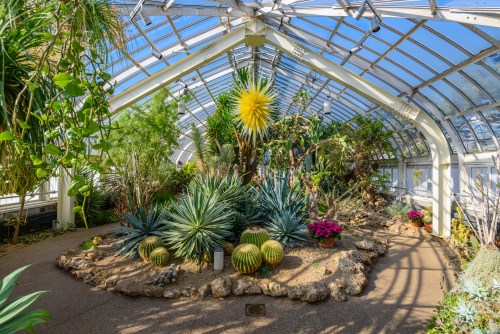
Phipps is home to acclaimed plant and art collections alike, attracting almost half a million guests from around the world each year. The fifteen-acre campus in Pittsburgh, PA, includes a historic fourteen-room glasshouse and twenty-three distinct gardens, and is home to renowned orchid and exotic plant collections. Flora and fauna are complemented by permanent art collections, including pieces by glass artists Dale Chihuly and Jason Gamrath. Phipps’ living and non-living collections have distinct needs and goals, as they are integrated together in our inspiring environment, combining the beauties of nature and art in one setting. This unique guest experience creates complex challenges in effectively showcasing and maintaining each collection. Our plant and art collections management policies—both recently approved by AAM—were developed by the curator of horticulture and the associate director of exhibits at Phipps in support of our mission: To inspire and educate all with the beauty and importance of plants; to advance sustainability and promote human and environmental well-being through action and research; and to celebrate its historic glasshouse.
The AAM accreditation process gave Phipps the opportunity to review and update our existing plant collection policy and formally document our art collection policy to reflect best management practices for museums. This process of reflection, discussion, articulation, and implementation of our policies has resulted in an organized methodology for decisions made around acquisitions, placement within the space, maintenance, and record-keeping centered on Phipps’ mission. In fact, Phipps has added a new position assisting the associate director of exhibits to support the need for consistent recording and conditions management revealed through this process. These policy documents also provide a continuity of established practices—which is exceptionally important within a historic, 125-year-old conservatory steadily pursuing the same goals and expected to continue doing so in perpetuity.
The two policies, while dramatically different in their scope, have many similar features. Both underline the importance of acquisitions that are both beautiful and culturally significant and are from an ethically good provenance. Both only permit accessioning items intended to remain in the permanent collection. Both require us to retain records on items existing and deaccessioned, to limit loans, and to have similar procedures for accessioning. The similarities among the policies intend to and succeed in establishing cohesive, memorable displays.
The plant collections policy dictates that taxonomic diversity is a goal, limited by the environmental category assigned by the themed rooms of the conservatory and by the showiness of the plant in question. The breadth of opportunity for acquisitions, thus, is large. Keeping adequate records is always an ongoing process, maintained by the plant recorder. Living things rarely remain in stasis—they grow (expanding beyond their assigned space), suffer from pests or disease, and die—and therefore require regular updates in the database. Iris BG, the program used by Phipps for this data, was developed by Havard Ostgaard in Norway and has become one of the premier programs of choice for collections management. Within this database, many background facts including location, health, provenance, and other valuable notes are stored.
As can be predicted, the maintenance of these records is very time consuming and requires the constant communication of the entire horticulture staff. There are lots of moving parts in a conservatory and so a regular inventory noting plant location and health becomes of the highest importance. We use these records to highlight the horticultural expertise of the Conservatory; to communicate the details of our collections to other public gardens, enthusiasts and researchers; and to gain national and international attention. If plants are deaccessioned in order to be sold, profits are ear-marked to go back into the collection budget, allowing us to further diversify it. We cultivate some explicitly focused collections such as the Barbara Tisherman Slipper Orchid collection, which preserves and grows species of historically important hybrid slipper orchids and is accredited by the Plant Collections Network, which is offered by the American Public Gardens Association and the USDA Agricultural Research Service. This plant group is not only display-oriented with large, ornate and oddly shaped flowers—providing joy to everyone who sees them—but it is also significant within the orchid community worldwide. The opportunity to compare these plants directly with each other at Phipps is truly special.
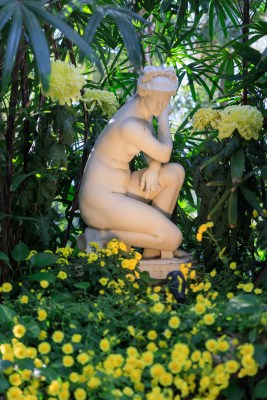
Since these collections are nested, it is important that we have open communication and work together to meet the collections’ needs. The curator of horticulture (who manages the plant collections) and the associate director of exhibits (who manages the art collection) regularly rely on each other and collaborate to make decisions. For example, if specimen trees need to be pruned above glass art, we work together to schedule a date for pruning and ensure that the glass is temporarily removed or protected the day prior and safely re-installed the day after.
It is important that our plant and art collections not only cohabitate but complement each other. Pieces must be chosen based upon how they fit into the living displays they are placed into. Within this framework, not only are plants specifically chosen for their aesthetic beauty, but the art chosen must enhance the overall experience in the display rooms. They are intended to bring attention to the plants and draw broad public admiration and inspiration. Art included in the collection must therefore be biophilic, evoking a connection with nature, as well as culturally relevant to the Phipps environment. For example, a set from Dale Chihuly’s Macchia series (seen in the photo above) are permanently displayed in our Palm Court. Sitting below towering palms, they are surrounded by Anthurium “Rancho Ruffles,” a low-growing but long and wide-leafed plant selected for the wavy leaf margins reflecting the wavy edges of the glass pieces.
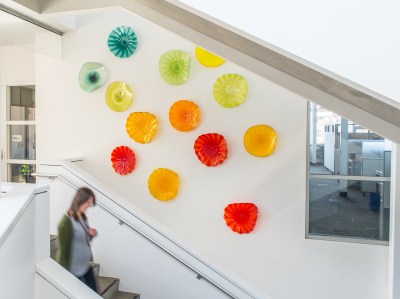
Many glass pieces currently within the Phipps collection began as commissioned showpieces. After Phipps’ record-setting success in showcasing Chihuly’s glass art in 2007, we have been bringing in glass art exhibitions that continue to delight guests, and we are cultivating a permanent glass art collection to be enjoyed long-term. The pieces that remain as permanent installations are thoughtfully integrated into the environment in such a way that people don’t see distinct parts, but instead see the natural beauty as part and parcel to the complete experience of each space. A piece acquired for permanent installation in the conservatory must also hold up to consistent humidity and moisture as well as exposure to sunlight. The collection is assessed on an annual basis to ensure all objects in the collection are still relevant to our mission and still meet selection criteria. If the team determines that a piece no longer meets these requirements, it is prioritized to be placed in the care of another nonprofit organization or cultural institution. This practice ensures that artwork that is developed or acquired continues to serve the public.
Phipps is an established landmark of Pittsburgh, PA, and we, as its stewards, aim to honor its history while taking it to ever greater and new heights through the continued advancement of our acclaimed plant and art collections. We encourage you to do the same, reaching new levels of success in your collections that will be treasured for generations to come.
About the Authors:
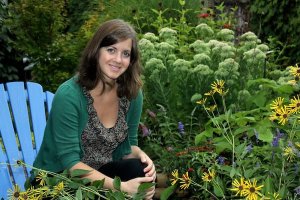 Jordyn Melino is the associate director of exhibits at Phipps Conservatory and Botanical Gardens, and has been with Phipps for over nine years. In her role, she designs and coordinates the majority of the garden’s seasonal flower shows, Winter Light Garden and Tropical Forest exhibits, manages the art collections, and curates the three art galleries on site. She holds great value in the design aspect of human interaction with the environment and always considers how guests will experience the exhibitions at Phipps. She has an undergraduate degree from Carnegie Mellon University in environmental science with a minor in photography, and a master’s degree from Chatham University in landscape architecture.
Jordyn Melino is the associate director of exhibits at Phipps Conservatory and Botanical Gardens, and has been with Phipps for over nine years. In her role, she designs and coordinates the majority of the garden’s seasonal flower shows, Winter Light Garden and Tropical Forest exhibits, manages the art collections, and curates the three art galleries on site. She holds great value in the design aspect of human interaction with the environment and always considers how guests will experience the exhibitions at Phipps. She has an undergraduate degree from Carnegie Mellon University in environmental science with a minor in photography, and a master’s degree from Chatham University in landscape architecture.
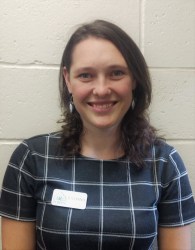 Dr. Julianna Razryadov is the curator of horticulture at Phipps Conservatory and Botanical Gardens in Pittsburgh, PA. She completed her doctoral work in non-conventional green roof plants and is passionate about educating the public regarding diversity in nature, especially through active experiences. Her goal at Phipps is to promote conservation through focusing attention on interesting and threatened plants around the world, including those found locally in Pennsylvania.
Dr. Julianna Razryadov is the curator of horticulture at Phipps Conservatory and Botanical Gardens in Pittsburgh, PA. She completed her doctoral work in non-conventional green roof plants and is passionate about educating the public regarding diversity in nature, especially through active experiences. Her goal at Phipps is to promote conservation through focusing attention on interesting and threatened plants around the world, including those found locally in Pennsylvania.
Connect with Phipps!
Website: phipps.conservatory.org
Twitter: @PhippsNews
Facebook: @phippsconservatory
Instagram: @phippsconservatory




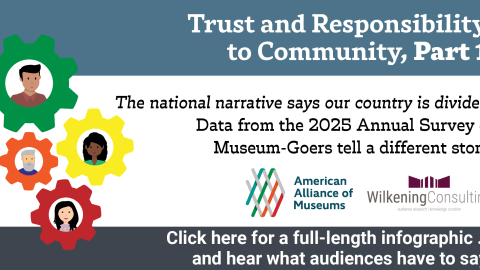
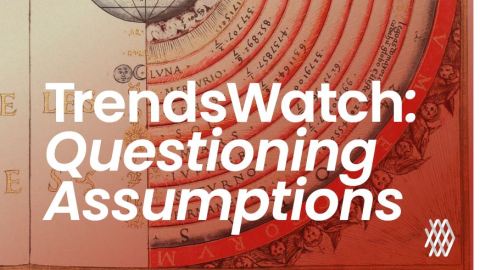


Dear Ms. Razryadov,
I would like to introduce myself; I am Jodean Brooks. I am a member of American Association of University Women, Beaver Valley Branch and co-chair for our Girls’ Recognition Night.
Girls’ Recognition Night is a program that recognizes eight grade young ladies from Beaver County Middle Schools who have an exceptional interest the field of math and science. The young ladies are selected by their Math and Science teachers for their enthusiasm and talent in Science and Math, components of the (STEM) subjects. The young ladies are recognized with a certificate and a pass to the Carnegie Science Center and this year the Science Mobile Lab will have a hands on program for the ladies.
A panel of four women who are currently working in one or more of the STEM areas discuss their education and careers. They describe their professions and give the young women an insight for the possibilities open to them as they continue their studies in the STEM fields. There is an opportunity for questions after the presentation. The program in partnership with Community College of Beaver County is held in April 16, 2020 at the CCBC Learning Resources Center.
I am in the process of looking for new speakers. Would anyone be interested?
Thank you,
Jodean Brooks